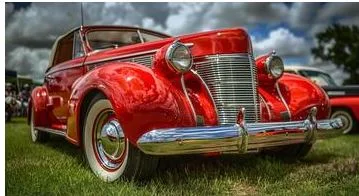How Old Style Electric Vintage Cars Are Redefining Mobility and the Role of Car Chargers?
The charm of an old style electric vintage car lies in its ability to combine retro aesthetics with modern technology. Nonetheless, this change comes with new problems and opportunities, particularly the energy management and charging infrastructure. To truly understand how these vehicles are reshaping mobility, we must explore their design, performance, and the crucial role car chargers play in sustaining their functionality.
Bridging Classic Design with Modern Engineering:
An old style electric vintage car reflects timeless craftsmanship while incorporating advanced electric vehicle (EV) technology. Car manufacturers have managed to preserve the beauty of vintage car models without losing the fuel power house to a plane electric powerhouse. This change not only modernized performance, but also supports the increasing need in the sustainable solution of mobility.
The exteriors of these cars are usually handmade to maintain a nostalgic effect with very detailed interiors as well as the use of high-quality materials. Simultaneously, advanced EV systems are integrated to make sure that acceleration is smooth, that work is silent, and that it is more energy efficient. Manufacturers pay close attention to the process of establishing both old-fashioned vintage design and innovative solutions that would help companies maintain equilibrium between those who care about the design and those who would also be aware of being environmentalist drivers.
Advancements in Electric Powertrains for Vintage Models:
Contrasting with traditional retrofitted models, modern, electric-vintage models are built ground-up to do electric. The high efficiency motors and light weight battery packs make these vehicles capable of providing better torque and smoother handling without losing the classic look.
The manufacturers normally utilize the lithium-ion battery or solid-state batteries which offer high range, for use in the city drives and on the recreational drive. Another innovation to note is that of regenerative braking systems that allow such cars to conserve energy, even as they decelerate. A combination of these features increases the efficiency and sustainability of driving in general, and allows electric vintage models to be usable in modern times.
Nevertheless, the achievement of the maximum battery performance should be connected with compatible charging systems. This is where advanced car chargers play a central role, ensuring reliable energy replenishment and long-term battery health.
Customization and Personalization in Electric Vintage Models:
One of the strongest appeals of an old style electric vintage car lies in its personalization potential. The unique features usually desired by the owners are customization including hand-made interiors, custom paint finish and custom detailing that draws inspiration with the classic auto styles.
In addition to aesthetic attributes, manufacturers also provide customization of performance. Regenerative braking strength, motor output and battery capacities can be changed to suit the individual driving preferences. That way would guarantee that every vehicle echoes the personality of their owners, and would be compatible with new charging solutions.
In order to feed this desired increase of personalization, car makers are coordinating with car charger makers to develop customized charging packages. These topographies are also created to accommodate the individual energies of older EVs so that charging can take place efficiently without the harm to battery health.
Market Growth and Industry Trends:
The demand for old style electric vintage cars is growing rapidly, driven by consumers who value both nostalgia and innovation. Luxury car manufacturers and small-scale manufacturers are also cashing in on the current trend and coming up with limited-edition models with target customers being collectors and enthusiasts.
Parallel to this growth, the market for car chargers is evolving to support specialized EV segments like vintage conversions. New wireless charging innovations, solar-integrated charging systems and ultra-fast DC solutions are transforming the EV ecosystem in general. Collectively, these innovations result in a car that is both easier to acquire and maintain now than it used to be in the past.
Moreover, the partnerships of the automotive brands, the battery manufacturers and the charging infrastructure firms are gaining pace to the growth of the world-wide charging networks. This complement increases accessibility whereby the owners of vintage EVs will enjoy long distance almost without hassle.
Challenges in Adapting Vintage Designs to Electric Systems:
Even with this progress, there are a number of engineering problems with incorporating electric drive trains into a classic car type. The preservation of structural integrity and the provision of large battery packs are just one of the main issues. Engineers need to weigh the distribution of weights with precision in order to safeguard the driving dynamics without changing the appearance of the vehicle in terms of its classic look.
Moreover, compatibility to current charging infrastructure needs to be ensured through standard connector design and optimal charging protocol, to an extent. In absence of such considerations, the owners can be restricted by the speed and availability of charging. Manufacturers have therefore put a lot of money into the research and development to address such issues and bring smooth consumer experiences.
Future Outlook: Driving Innovation Forward
The future of old style electric vintage cars looks promising, supported by continuous advancements in EV technology and charging infrastructure. Producers are projected to produce larger, higher capacity batteries that would take a shorter time to charge, thus making these cars even more convenient for daily use.
Emerging trends such as bidirectional charging and energy-sharing capabilities are also reshaping the role of car chargers. Such systems will also enable the store of the vintage EVs to feed back power to homes or grids, converting vehicles into energy storage units.
With the development of the EV ecosystem, there will be an increasing involvement of traditional automotive design and current technological innovation. A wider range of vintage-inspired electric models will benefit the consumers and is backed by more advanced charging capabilities that would meet different energy needs.
Conclusion:
The resurgence of the old style electric vintage car represents more than a nostalgic return to classic designs; it symbolizes the fusion of tradition and innovation. Paired with advancements in car chargers and charging infrastructure, these vehicles are redefining how we perceive sustainable mobility.
Through further collaboration between carmakers and battery engineers and charging infra-structure specialists, the future is expected to become largely smooth in its operation, more accessible, and unlimited in terms of customization. The combination of classic design and high-tech power technologies offers a guarantee that the purchases of electric vintage cars are not only saving history but actively creating the future of humanity in the future.





